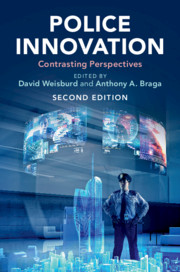Book contents
- Police Innovation
- Police Innovation
- Copyright page
- Contents
- Figures
- Tables
- Notes on Contributors
- Introduction
- Part I Community Policing
- Part II Procedural Justice Policing
- Part III Broken Windows Policing
- Part IV Problem–Oriented Policing
- 7 Advocate
- 8 Critic
- Part V Pulling Levers (Focused Deterrence) Policing
- Part VI Third–Party Policing
- Part VII Hot Spots Policing
- Part VIII Predictive Policing
- Part IX CompStat
- Part X Evidence-Based/ Risk-Focused Policing
- Part XI Technology Policing
- Index
- References
8 - Critic
Problem-Oriented Policing: The Disconnect between Principles and Practice
from Part IV - Problem–Oriented Policing
Published online by Cambridge University Press: 09 August 2019
- Police Innovation
- Police Innovation
- Copyright page
- Contents
- Figures
- Tables
- Notes on Contributors
- Introduction
- Part I Community Policing
- Part II Procedural Justice Policing
- Part III Broken Windows Policing
- Part IV Problem–Oriented Policing
- 7 Advocate
- 8 Critic
- Part V Pulling Levers (Focused Deterrence) Policing
- Part VI Third–Party Policing
- Part VII Hot Spots Policing
- Part VIII Predictive Policing
- Part IX CompStat
- Part X Evidence-Based/ Risk-Focused Policing
- Part XI Technology Policing
- Index
- References
Summary
Problem-oriented policing works to identify why things are going wrong and to frame responses using a wide variety of innovative approaches (Goldstein, 1979). Using a basic iterative approach of problem identification, analysis, response, assessment, and adjustment of the response, this adaptable and dynamic analytic approach provides an appropriate framework to uncover the complex mechanisms at play in crime problems and to develop tailor-made interventions to address the underlying conditions that cause crime problems (Eck & Spelman, 1987; Goldstein, 1990). Many police departments have experimented with the approach and the available evaluation evidence suggests that problem-oriented policing is a fundamentally sound approach to controlling crime and disorder problems (Skogan & Frydl, 2004; Weisburd & Eck, 2004; Braga, 2008; Weisburd et al., 2010). The US National Academies of Science, Engineering, and Medicine Committee on Proactive Policing recently reviewed the more rigorous evaluations of problem-oriented policing and concluded that these programs lead to short-term reductions in crime and disorder (Weisburd & Majmundar, 2018).
- Type
- Chapter
- Information
- Police InnovationContrasting Perspectives, pp. 182 - 202Publisher: Cambridge University PressPrint publication year: 2019
References
- 7
- Cited by



